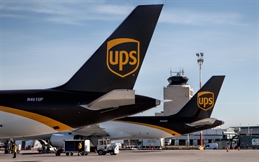
Lufthansa Cargo has been adding Boeing 777-200 freighters to its fleet at the rate of knots. Last year it took delivery of three 777-200Fs, and this February it announced an order for another – its 10th altogether, which is due to enter service in the fall. Combined with four 777-200Fs in CargoLogic, the joint venture with DHL, the German carrier will have 14 777 cargo aircraft at its disposal.
Dorothea von Boxberg, CEO and chair of the executive board of LH Cargo, recently revealed interest in more freighters. “We are in discussions with Boeing and lessors about the availability of other 777s,” she said.
For now, the carrier is holding on to its aging MD-11s. Originally, they were scheduled to exit service by the end of last year, but buoyant demand prompted management to hold on the type. However, their role at LH Cargo will end later this year. All but three were sold already, but the buyer agreed to take them at a later date. A fleet of just three aircraft would not be viable, von Boxberg said.
A lot of carriers have reactivated parked older freighters or are hanging on to planes that were supposed to be out of service by now. UPS is in the process of replacing the cockpit computers on its fleet of A300-600 freighter that were purchased some 20 years ago.
Those old computers can’t store full navigational maps, but the aircraft are still needed at a time when traffic volumes are in the stratosphere.
UPS CEO Carol Tome has emphasized the importance of “sweating the assets” by boosting efficiency with scaled down investment.
Carriers are looking to boost their all-cargo fleets. LATAM Cargo, the largest cargo carrier from Latin America, signed an agreement with Boeing at the beginning of March to convert four of its 767-300ER passenger planes into an all-cargo configuration; they are due to join its fleet next year. Four more will likely follow in 2023, as LATAM signed up for four options, which are likely to be exercised, according to LATAM Cargo CEO Andres Bianchi.
If this goes ahead, LATAM’s freighter fleet will grow from currently 10 767Fs to 19, an increase of 80%.
Air Canada Cargo is also turning 767-300s into freighters, and it stepped up its efforts in early March. Having earlier signed an agreement to convert two 767s, it subsequently announced plans to add five more with the intention of having a fleet of seven freighters in operation in time for the 2022 peak season.
Aircraft conversions outfits are running at full throttle, from 737s over A321s and 757s to 767s. Elbe Flugzeugwerke, the joint venture between Airbus and ST Aero, reserved on of its induction slots for this year for an A320, marking the start of active conversion work on that type.
The International Air Transport Association noted that in January bellyhold capacity on international routes was down 49%, whereas freighter capacity had increased by 29%.
Between last May and February 61 narrowbody freighters and 80 mid-sized cargo planes joined the global freighter fleet, according to aviation consultancy IBA. Except for a few 767-300ERFs, all of the newcomers in these segments were converted planes.
All of these aircraft types have ample feedstock that is available at historically low prices. As airlines are retiring lots of aircraft and cutting down the number of types in their fleets, residual values of these types have dropped significantly.
According to some observers, the freighter market over the coming years will be hugely dominated by conversions. Narrowbody freighters are virtually all converted ex-passenger planes, and the widebody segment currently has only two active freighter production programs – for the 767 and the 777. However, in that sector conversion capacity is limited, as there are no conversion kits left for 747s and MD-11s.
In addition to taking five more 767 freighters, Cargojet, Canada’s largest freighter airline, has signed an agreement to take on two converted 777-300s, plus options for another two.
With the 777 the carrier is looking to push more into international markets, where its presence is currently limited to two weekly flights through Halifax to Cologne. The 777 will allow it to enter the trans-Pacific market as well as fly to South America, said executive vice president Jamie Porteous.
“We see demand for international air cargo remain strong for the next 3-5 years minimum,” he said, adding that Cargojet could fill the aircraft today if they were available.
The window for conversions extends well beyond the current market conditions, but operators and pundits alike are positive that demand for cargo capacity will remain high, with limited capacity available. Logistics Capital & Strategy, a strategic supply chain consultancy, estimates that only 80% of the belly capacity lost in the Covid-19 slump will return to service.
Moreover, a lot of the more than 500 widebody passenger planes that have been retired will be replaced with Airbus 321s, which have limited cargo capacity, necessitating more freighter lift, said managing director Brian Clancy.
And as passenger volumes rise and cargo yields retreat, passenger planes that have been deployed for cargo missions will disappear from the freight scene, as their operating economics have tight margins, von Boxberg said.
One carrier executive that is using ‘preighters’ said that results are carefully monitored. A decline in yield, which could be triggered by rising fuel costs, could make some routes not viable, he added.
Freighters will remain in high demand, and limited capacity will keep rates elevated, Clancy warned. Most likely this will prompt larger forwarders to use dedicated freighters to secure adequate capacity, especially as long as market conditions and capacity remain volatile.
By Ian Putzger
Air Freight Correspondent | Toronto



